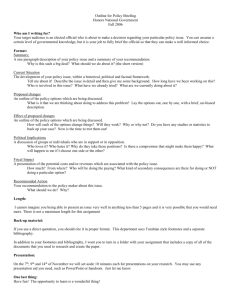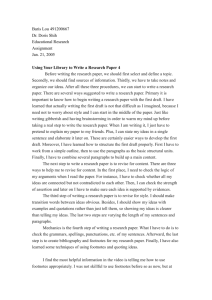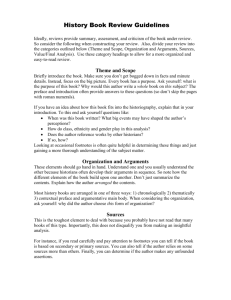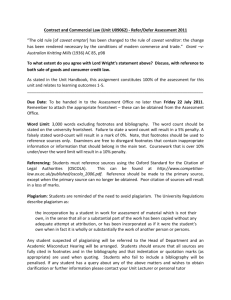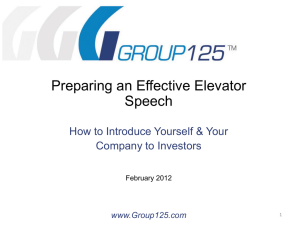Chapter 8 - Faculty Websites
advertisement
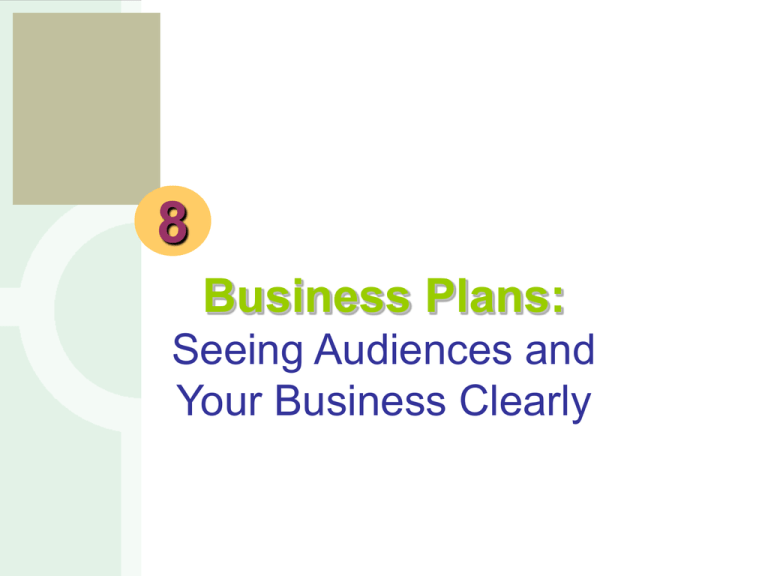
e s b 8 Business Plans: Seeing Audiences and Your Business Clearly e s b Chapter 8 Business Plan Background • Business plan: document designed to detail major characteristics of a firm • 2 circumstances when a business plan is necessary: – External legitimacy – Internal understanding 8-2 e s b Chapter 8 • External legitimacy: extent to which a small business is taken for granted, accepted, or treated as viable by organizations or people outside the small business or the owner’s family • Internal understanding: extent to which employees, investors, and family members in the business know the business’s purposes and operations 8-3 e s b Chapter 8 Starting Small and Building Up 8-4 e s b Chapter 8 • The Vision Statement – 5-10 word sentence or tagline • Tagline (or mantra): memorable catchphrase that captures the key idea of a business • Good way to present a vision statement – Microsoft: “A computer on every desk, running Microsoft software.” – Starbucks: “Rewarding everyday moments.” 8-5 e s b Chapter 8 • The Mission Statement – A paragraph that describes the firm’s goals and competitive advantages – Talks in terms of how it will make a difference in for the customer or the industry – Fantastic Gift Baskets: “The family at Fantastic Gift Baskets puts the same care and love into designing our gourmet gift baskets as you would…if you had the time!” 8-6 e s b Chapter 8 • The Elevator Pitch – A 30-second action-oriented description of a business designed to sell the idea of the business to another – Leads with the hook, follows up with purpose of the service, ends with where business is now – What makes firm unique or superior? – Sounds like a sales pitch 8-7 e s b Chapter 8 Example The 30-Second Business Plan • “Elevator pitch"--a carefully prepared, wellrehearsed summary of who you are, what you do and why you are better at it than anyone else • Verbal equivalent of your business card, but it needs to say much, much more, and it needs to say it very quickly • Practice, practice, practice - You never know when you will need your elevator pitch http://www.entrepreneur.com/money/financing/article58946.html 8-8 e s b Chapter 8 • The Executive Summary – Key component of the written business plan – One- to two-page (250-500 word) overview – Product, market, competitive advantages, management, business, finances – Single most important written part of plan • Most widely distributed • Readers typically start with executive summary 8-9 e s b Chapter 8 The Classic Business Plan • Full (or classic) business plan: 25 single-spaced pages of text and 15 pages of financials and appendices • The 5 M Model (or one page business plan) – – – – – Mantra Mission Measures Method Mechanics 8-10 e s b Chapter 8 8-11 e s b Chapter 8 Business Plan Outline • Cover letter: one page document on business stationery – Introduces business plan and owner – Indicates why recipient is being asked to read the plan 8-12 e s b Chapter 8 • Title Page: contains introductory information – – – – – Company name Contact information Date this version of the plan was completed Proprietary statement to protect your ideas Possible items: • Securities disclaimer • Name of person who prepared the business plan • Notice of copyright for the plan, or brands/logos 8-13 e s b Chapter 8 • Table of contents: – Lists major section headings • Boldface type – Sections underneath major sections • Normal type – Put page numbers on every page of the business plan 8-14 e s b Chapter 8 • The Company: – Company description: 1-2 pp. • Vision statement / mission statement • Specific goals • Company background: brief description of the company, the firm’s current status, and the history of the business • Business’ competitive advantage 8-15 e s b Chapter 8 • The Company: – Product/service and industry: 1-8 pp. • • • • • Describe firm’s product or service Include pictures Explain how the customer uses the product Proprietary technology Industry descriptions 8-16 e s b Chapter 8 • The Market: – Market and target customer: 1-3 pp. • Total population of people or firms you plan to sell to • Target customer section: focuses attention on who would buy – Demographics’ relation to the product, how often they buy, and past experience – Common to have multiple target audiences 8-17 e s b Chapter 8 • The Market: – Competition and competitive advantage: 1-2 pp. • Table: 1 p. – Major competitors – Competing product or service: market share, price, competitive advantages and disadvantages • Text: 1 p. – what makes product or service unique 8-18 e s b Chapter 8 • The Market: – Marketing strategy: 1-3 pp. • Overall strategy your firm pursues in the market • Sales plan that shows specific ways you apply strategy to secure sales from your customers • Longer-term competitive plan that shows how you protect your firm from efforts of the competition to unseat you 8-19 e s b Chapter 8 • The Organization: – Legal and organization structures: 1/2-1 p. • Legal form of the business • Organizational structure of the firm • Makes clear how many employees there are and whether they are full time or part time, permanent or seasonal, family or non-family 8-20 e s b Chapter 8 • The Organization: – Key personnel: 1/2-3 pp. • Sell the most important single element in the business plan – you! • Who are your key personnel? • Talk about accomplishments rather than just experience • Do not limit yourself to business 8-21 e s b Chapter 8 • The Organization: – Related service providers: 1/2-1 p. • Identify your bank and banker, attorney and legal firm, accountant or bookkeeper, other consultants • Major relationships established with wellknown suppliers or customers • Board of directors / board of advisors 8-22 e s b Chapter 8 • The Organization: – Location: 1/2 p. • Description of the facility • How it meets strategic and sales goal of the business • Own, lease, or rent the property • Plan to expand the facilities 8-23 e s b Chapter 8 • The Financials: – Page 1: Critical assumptions – Page 2: The deal (if the plan is going to investors) – Page 3: Income statement for Year 1, by month; assumptions marked by footnotes – Page 4: Income statement for Year 2, by month, and Year 3 (and later if needed) by year; assumptions marked with footnotes 8-24 e s b Chapter 8 • The Organization: – Page 5: Cash flow statement for Year 1, by month; assumptions marked with footnotes – Page 6: Cash flow statement for Year 2 by month, and Year 3 (and later if needed) by year; assumptions marked with footnotes – Page 7: Balance sheet for years 1-3 (or 1-5) by year; assumptions marked with footnotes – Page 8: Start-up cost budget – Page 9: Assumptions page for financial statements 8-25 e s b Chapter 8 • The Appendices: – Most popular appendix: one-page version of owner’s resume – Product or service pictures or specifications – Copies of signed contracts – Results from marketing studies or pilot sales efforts – Industry reports – Price lists for products or services – Advertising copy 8-26 e s b Chapter 8 Example College Business Plans that Made the Grade • Student Ian Leopold was just one class away from graduating when his economics professor failed his business plan assignment • Earned his degree and in his spare time turned his business plan into a reality, entering Northwestern's Kellogg School in the fall • On the side, he was making thousands of dollars each week putting together ads for his Unofficial Student Guide • In five years, Leopold had turned his failed assignment into a successful company with nearly $3 million in revenue http://www.entrepreneur.com/startingabusiness/businessplans/article182608.html 8-27 e s b Chapter 8 Focusing Your Business Plan • Pioneering business: product is truly new • New entrant business: product or service already exists – Firm is first of its kind in your market • Existing business: entrepreneurs start a business before they write a plan for it • Business with significant government involvement: zoning, environmental impact 8-28 e s b Chapter 8 • Screening plan: basic overview of the firm and detailed look at the financials • Information plans: gives potential customers or suppliers information about the company and its product or service • Proof-of-concept website: internet-based type of plan designed to solicit information on customer interest 8-29 e s b Chapter 8 • Invention plan: provides information to potential licensees • Operational plans: used as working document within a business – Includes detailed specifications of the major techniques, methods, recipes, formula, and sources used by the firm to do its work 8-30 e s b Chapter 8 Critical Risks • • • • • • Overstated numbers Uncertain sales (especially conversion rates) Overlooked competition Experience deficits Inadequate cushion Inadequate payback 8-31 e s b Chapter 8 • Circle of advisors: – Review the plan and help identify the critical risks and your coverage of them • • • • Service Corps of Retired Executives Small Business Development Center Ibis Associates Kauffman Foundation’s Business EKG website • BizStats 8-32 e s b Chapter 8 Presenting Your Plan • Plan presentations usually last 10-15 minutes – 15 or more minutes for questions • Key things: – – – – Your passion for your business Your expertise about the business and the plan How professional you are in your work How easy it would be to work with you 8-33

